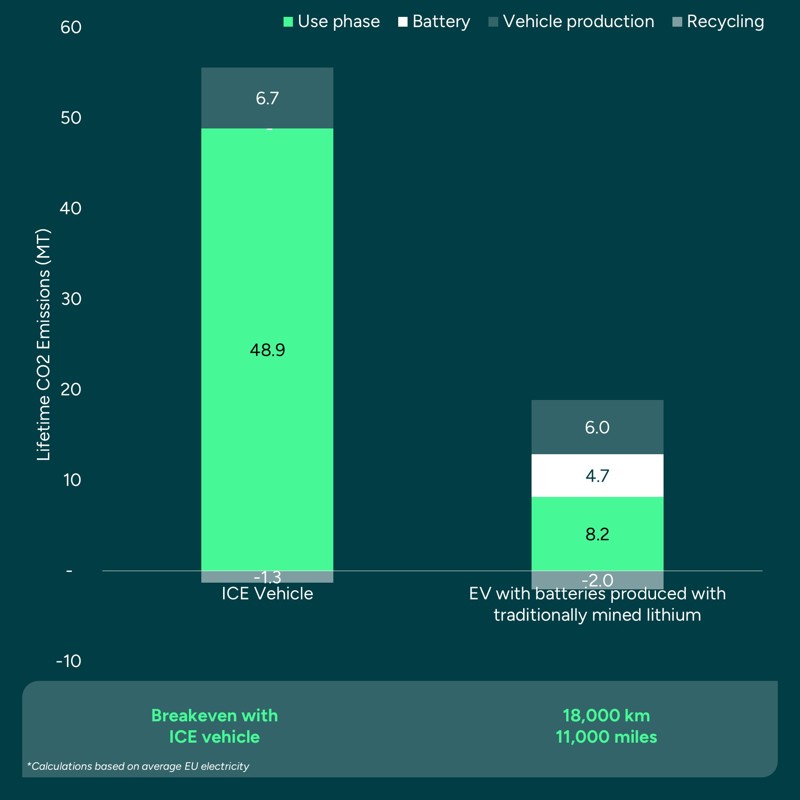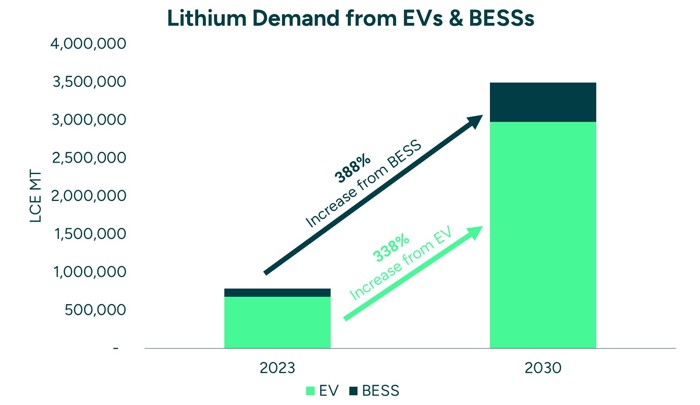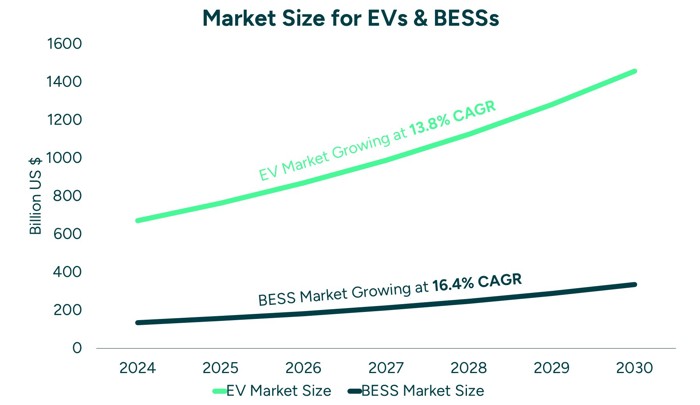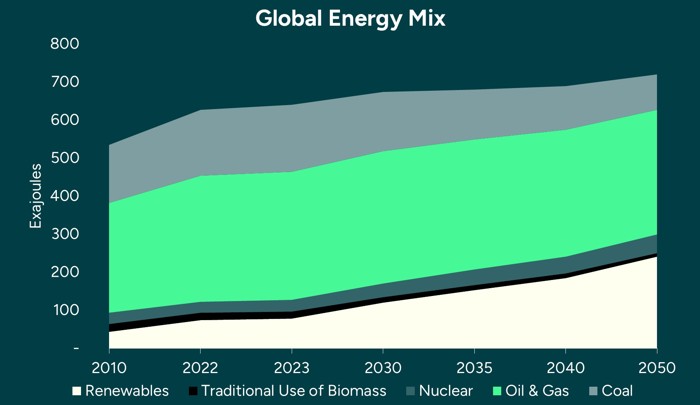The Perfect Marriage Between Oil & Gas and Renewables
Discover how the perfect marriage between oil & gas and renewable energy can accelerate decarbonization, secure critical mineral supply chains, and unlock a more resilient, sustainable future.
Introduction - Rethinking the Energy Debate
The energy world is often framed as a battleground: oil and gas vs. renewables.
One side is legacy; the other, the future.
But that narrative no longer fits the moment we're in.
Global energy demand is rising, up 12.5% by 2050, and climate goals are more urgent than ever. Despite decades of pledges and progress, greenhouse gas emissions reached a record 53.0 gigatonnes in 2023, with 73.7% coming from the combustion of fossil fuels.
The energy system is under pressure from all sides.
Meanwhile, oil and gas still supply more than half of the world's primary energy, even as wind, solar, and EV adoption accelerate. And as electrification surges, securing the supply chain for critical minerals, like lithium, becomes just as important as expanding clean energy itself.
This isn't a story of replacement. It's a story of reinvention - and more innovative integration.
Because the fastest way to reduce emissions isn't dismantling the old system, it's reimagining how it fits into the new one.
- Switching from gas-powered vehicles to EVs tackles the single largest source of CO₂ emissions.
- Adding more renewables helps meet growing energy demand affordably and sustainably.
- Extracting lithium from oil and gas wastewater turns a liability into a clean-energy asset.
- Embracing a diversified energy mix gives us the flexibility and resilience the world needs.
A future shaped by the perfect marriage between oil and gas and renewables.
Featured Talk: CERAWeek 2025
Want the executive perspective behind this blog?
Watch Sune Mathiesen, CEO of Lithium Harvest, present “Securing the Supply Chain of Critical Minerals for the Energy Expansion” live at CERAWeek 2025, where industry leaders came together to shape the future of energy.
Explore the full story of energy integration and lithium innovation below.
The Environmental Challenge
Despite years of climate pledges and progress in clean energy, emissions are still heading in the wrong direction.
In 2023, global greenhouse gas emissions reached a new peak of 53.0 gigatonnes of CO₂ equivalent. The main driver remained unchanged: 73.7% of those emissions came from the combustion of fossil fuels.
Two sectors dominate this challenge:
- Transportation is the single largest emitter of CO₂
- Electric power generation is the second-largest
If we can address just these two sectors - through electrification and clean energy - we can make a real dent in global emissions over the next decade.
And the science is clear: electrifying transportation and scaling renewable energy are the fastest and most effective ways to reduce emissions. Switching from combustion engines to electric vehicles directly targets the largest source of CO₂. Expanding wind and solar reduces our reliance on carbon-heavy power generation, but to make clean power available around the clock, energy storage has to scale with it.
Of course, this transition comes with its own demands.
A cleaner energy future depends on battery minerals, and how we source them matters. Traditional mining for lithium, nickel, and other critical materials is energy- and water-intensive. In some parts of the world, it also brings serious environmental and social challenges.
If we’re serious about decarbonization, we need to scale electrification responsibly, using battery materials as clean as the technologies they power.
At the same time, global energy demand continues to rise. Electricity use grew 4.3% in 2024, outpacing GDP growth. Renewables are expanding, but they often add to the energy mix instead of replacing fossil fuels.
This isn’t just an emissions problem - it’s a systems challenge. And solving it means rethinking how we source, power, and connect the energy expansion.
Global emissions are rising. A cleaner energy future demands smarter solutions - starting with sustainably mined critical minerals.
The Road to Net Zero Starts with the Vehicle
EVs aren’t better for the environment - or are they?
Fossil fuel combustion is still the primary driver of global CO₂ emissions, and transportation is one of the fastest-growing and most visible contributors. So what's the most effective way to tackle it? Electrify the vehicle fleet.
Battery electric vehicles (BEVs) emit 45–65% less CO₂ over their lifetime than combustion-engine cars, even when you factor in manufacturing and electricity use. On average, one EV can save up to 50 tonnes of CO₂ and typically hits its emissions breakeven point after just 11,000 miles (18,000 km).
At scale, the impact is enormous. By 2035, EV adoption is expected to avoid 2.6 gigatonnes of CO₂ - that's roughly equal to the annual emissions of the entire European Union.
But here's the catch: every EV runs on a battery, which depends on critical minerals like lithium. These minerals must be mined, refined, and transported before a single clean mile is driven.
If we're serious about electrifying transport at scale, we must ensure that the battery's contents are as clean as the discharge.

Sustainable mining of battery materials is key to further cutting EV lifetime emissions.
How We Make EVs Even Cleaner
Electrifying transportation is essential, but EVs are only as sustainable as their supply chain.
Most of the emissions associated with electric vehicles come from battery production, particularly the sourcing and refining of critical minerals like lithium. Traditional mining methods, including open-pit extraction and evaporation ponds, are resource-intensive, slow to scale, and harmful to the environment.
That's why making EVs truly green means going beyond the vehicle itself.
At Lithium Harvest, we've developed a sustainable alternative that transforms how battery materials are sourced - and how clean an EV really is.
Our carbon-neutral extraction technology significantly cuts emissions from car manufacturing:
- Up to 47% lower CO₂ emissions from battery-grade lithium production
- No open-pit mining or destructive evaporation ponds
- Efficient extraction from oilfield wastewater and geothermal brines
- 3x faster EV breakeven - batteries using our lithium reach breakeven in just 3,500 miles, compared to 11,000 miles with conventional sources

The World Is Facing a Lithium Shortage
The global expansion of green energy has triggered a surge in lithium demand, and the world is struggling to keep up.
As countries race to decarbonize and electrify, lithium demand is projected to grow 3.5 times between 2023 and 2030 and 6.5 times by 2034. This surge is driven by the rapid adoption of EVs and the expansion of battery storage, but it’s also putting severe pressure on the supply chain.
The outlook is sobering:
- A critical lithium shortage is expected by 2029, or even sooner
- Market volatility and long permitting timelines are already delaying new supply projects
- By 2030, the base case supply gap could be nearly 4x current production levels
- In the long term, 55-65% of the forecasted lithium supply is at risk between 2030 and 2040, and without new projects or advanced recycling, that gap could nearly double by 2040
The clock is ticking.
To secure the energy expansion, we need faster, cleaner, and more resilient ways to bring lithium to market.

Why Traditional Lithium Mining Can't Meet the Moment
Most of today’s lithium still comes from open-pit mines or evaporation ponds - methods that are water-intensive, slow to scale, and often environmentally damaging. Projects can take 5 to 15 years to become operational, and many face community opposition or regulatory delays.
To meet exploding global demand without deepening environmental and social costs, the world needs better solutions - ones that are:
- Faster to deploy
- Scalable in new locations
- Environmentally responsible
- Less exposed to global price volatility and permitting risks
New approaches, like Direct Lithium Extraction (DLE), particularly from produced water and geothermal brines, offer a way forward. They unlock new supply sources while significantly lowering environmental impact.

Lithium Demand Drivers - EVs & BESSs Fueling the Future
So, what’s behind the surge?
As the world races to decarbonize, lithium is becoming one of the most critical building blocks of the clean energy economy.
The rise of electric vehicles and battery energy storage systems (BESSs) is driving unprecedented demand, and it’s only accelerating.
EVs: Driving Demand
- 87% of lithium demand by 2030 will come from electric vehicles
- The global EV fleet is expected to grow more than 8.5x by 2035, reaching over 500 million vehicles
- EV battery production alone will require millions of tonnes of lithium carbonate equivalent (LCE) annually

BESSs: Powering the Grid - and Beyond
- Grid-scale battery storage demand is projected to rise 280% by 2030 (+450 GWh).
- BESSs are essential for stabilizing power grids as intermittent renewable sources like solar and wind increase.
- By the end of the decade, 13% of lithium demand will come from energy storage systems alone.
However, the role of BESS is expanding far beyond grid-scale stabilization.
As we move toward a more decentralized energy future, lithium-ion battery systems are being installed in homes, factories, commercial buildings, and local microgrids - bringing clean, flexible power closer to where it's needed. In a world that demands both resilience and decarbonization, BESS will be foundational.
Learn more about how lithium is powering the renewable energy revolution.
This is no temporary spike - it's a structural shift. Unlike fossil fuels, lithium isn't burned. Instead, it's built into long-lived energy assets whose value compounds over time.
That's why securing a reliable and sustainable lithium supply is more critical than ever.

EVs continue to drive lithium demand, and the rapid growth of intermittent renewable energy sources is pushing it even further.
The Diversified Energy Future - Addition, Not Transition
A perfect marriage between old energy and new energy.
Renewables are booming - global capacity is expected to grow by +209% by 2050. Electrification is accelerating. Wind and solar are breaking records. Battery storage is scaling faster than ever. But this isn't a replacement story - it's a reinforcement story.
Global energy demand is set to rise 12.5% by 2050, and while renewables are essential, they can't shoulder the entire load alone, especially not on the timeline the climate crisis demands. Even under the most ambitious climate scenarios, oil demand is projected to keep rising through 2030 and will remain a part of the energy mix for decades.
Why? Not because oil is growing as a share of energy supply, but because oil is used for far more than fuel. From plastics and chemicals to industrial products and construction materials, oil remains embedded in the modern economy far beyond combustion.
Electric vehicles are expected to displace only 6 million barrels of oil per day by then, still only about 5% of the total global oil demand. This isn't a story of substitution.
This isn't a story of substitution. It's a story of addition and transformation.
Here’s why that matters:
- Targeting electrification barely dents the oil and gas industry, but it delivers massive CO₂ savings.
- Transportation is the world’s largest source of CO₂ emissions, and EVs directly address that.
- The oil & gas industry holds underutilized resources - like lithium-rich wastewater - an overlooked feedstock that can become a cornerstone of clean battery production.
- Lithium recovered from oilfield wastewater helps scale BESS, supporting grid stability and ensuring renewables deliver consistent, reliable power.
This is energy integration in action. Repurposing oilfield infrastructure to solve renewable challenges.
Electrification doesn't have to hurt oil & gas - it can empower it. By turning what was once discarded into something essential, we're not just reducing emissions but transforming the system.
Because the future of energy isn't divided - it's diversified, integrated, and built on innovative collaboration.

The future of energy isn't about choosing between oil and renewables - it's about integrating them into a balanced, more sustainable energy mix.
By extracting lithium from oilfields, we're turning today's infrastructure into tomorrow's solutions - accelerating a more sustainable future.
Rethinking Critical Minerals Supply
Why look overseas when the solution is right below our feet?
As EVs, battery storage, and renewable technologies scale, the demand for critical minerals - especially lithium - is exploding. But today's supply chain isn't keeping up.
Most lithium still comes from hard rock mines and evaporation ponds, often far from manufacturing centers. These methods are carbon-intensive, water-heavy, and take years to develop. Processing and refining are concentrated in just a few countries, which increases costs, creates geopolitical risks, and delays the entire transition.
Meanwhile, governments and companies continue to search for minerals in remote areas with poor infrastructure, adding complexity, instability, and environmental impact.
And here's the irony: while the world looks abroad, a scalable, domestic solution already exists - hidden in plain sight.
Produced water, a byproduct of oil and gas operations, is generated at a rate of 4–5 barrels for every barrel of oil. Globally, that adds up to over 250 million barrels per day. What was once a costly waste stream is now an opportunity - a consistent, high-potential feedstock for battery-grade lithium, ready to be unlocked with the right technology.
It's time to shift our thinking. The future doesn't need to be built on new footprints - it can be built on the ones we already have.
Why rely on distant, high-cost sources when the solution is right below our feet?
Securing the Supply Chain of Critical Minerals for the Energy Expansion
If the world is serious about scaling clean energy, it must also be serious about securing the materials that power it. We can't expand clean energy without rethinking how we source the materials that power it.
From electric vehicles to grid-scale batteries, lithium is no longer optional - it's foundational. But the way we extract and supply it must evolve.
That's where Lithium Harvest comes in. We do it a little differently.
We've developed a sustainable, scalable technology that turns oilfield wastewater into high-purity, battery-grade lithium. This unlocks a new domestic resource without compromising the environment.
This isn't just about supply. It's about synergy.
Lithium Harvest is the perfect marriage between oil & gas and renewables:
- Leveraging existing infrastructure to power the energy future
- Sourcing critical minerals locally, quickly, and sustainably
- Delivering a model that's both commercially viable and climate-positive
It's not a transition. It's a transformation - from waste to value, from old systems to smarter ones, from fossil-only thinking to integrated, forward-looking energy strategies.

Green Energy Transition
You may also be interested in:

